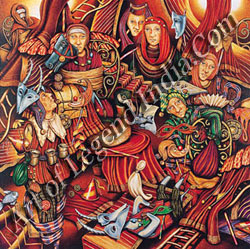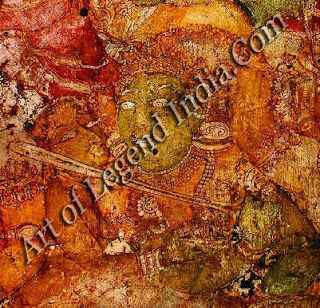 The
colours are soft and subdued, the lines firm and sinewy, the expression true to
life and, above all, there is an ease in the contours of these figures which
have a charm of their own.
The
colours are soft and subdued, the lines firm and sinewy, the expression true to
life and, above all, there is an ease in the contours of these figures which
have a charm of their own.
In the
ninth century, the Cholas regained power, when Vijayalaya established himself
in the area round about Tanjavur. Aditya and Parantaka, the son and grandson of
Vijayalaya, were great temple-builders. Parantaka was specially devoted to Siva
at Chidambaram and covered the temple with gold. The widowed queen of the pious
king, Gandaraditya, son of Parantaka, is one of the most important queens in
Chola history for the generous tradition of building and endowing temples. The
most imposing monu-ment of the Chola period is the Rajarajesvara temple at
Tanjavur, also known as the Brihadisvara temple. Rajaraja was undoubtedly the
greatest ruler in the Chola line, great in military triumph, in organisation of
the empire, patron-age of art and literature, and in religious tolerance. In
the twenty-fifth year of his reign, a great and magnificent temple of Siva,
named after the king, Rajarajesvaramudayar, was completed. Rajaraja was so
intensely devoted to Siva that he was known by the epithet Sivapadasekhara. His
taste for art is reflected in the title Nit yavinoda. Rajaraja's glory was
partially eclipsed by that of his greater son Rajendra, who was a remarkable
military genius. Rajendra, on his return from a successful campaign in the
Gangetic area, created a huge tank, symbolic of a liquid pillar of victory, in
his own new capital, Gangaikondacholapuram, and a gigantic temple, resembling
the Brihadisvara at Tanjavur, to celebrate his triumph and the bringing home of
the Ganges water as the only tribute he sought from the vanquished sovereigns
of the North.
Kulottunga
II, the son of Vikramachola, made elaborate additions to the Chidambaram
temple. This interest was sustained in the reign of his son Rajaraja H whose
biruda, Rajagambhira, is recorded in the lovely rnandapa of the temple at
Darasuram, built during his time. Kulottunga III was the last of the great
Chola emperors to add to the Chola edifices, not only by building temples like
the Kampaharesvara at Tribhuvanam, but also by renovations and additions as at
Kanchi, Madurai, Chidambaram, Tiruvarur, Tiruvidaimarudur and Darasuram.
There
are fragments of very early Chola paintings at Narthamalai, Malayadipatti and
other places. However, it is the Brihadisvara temple at Tanjavur that is a real
great treasure-house of the art of the early Chola painter. The contemporary
classics describe the glory of the paintings in the South by referring to chit
ramandapas, chitrasalas, oviyanilayams in temples and palaces. The Paripadal
men-tions the paintings on temple walls in the early Chola capital,
Kaveripumpattinam. The actual remains of this period are, however, yet to be
discovered. In the Vijayalayacholisvaram temple on the hill at Narthamalai,
there are traces of paintings on the walls showing the dancing figure of Kali
and Gandharvas on the ceiling of the antechamber.
S.K.
Govindaswami's discovery of paintings in the dark circumambulatory passage
around the central shrine in the Brihadisvara temple at Tanjavur revealed a new
phase of South Indian painting, a regular picture gallery of early Chola art.
There are two layers, one of the Nayak period on top, which, wherever it has
fallen, has revealed an earlier Chola one below, richly laden with painting.
The
entire wall and the ceiling were originally deco-rated with exquisite paintings
of the time of Rajaraja, but later renovation and additions made during the
centuries account for additional layers that have covered up the earlier one.
These Chola paintings that form an important link in the series help a better
study of the earlier Pallava phase and the later Vijayanagara. The Chola
paintings so far exposed are mainly on the western and northern walls. On the
western side, the entire wall space consists of a huge panel with Siva as
Yoga-Dakshinamurti, seated on a tiger-skin in a yogic pose, with the yogapatta
or paryankabandha across his waist and right knee, calmly watching the dance of
two apsaras. A dwarf gana and Vishnu play the drum and keep time, while other
celestials in a row sound the drum, the hand drum and the cymbals, as they fly
in the air, to approach this grand spectacle, which is witnessed by a few
principal figures seated in the foreground. Saint Sundara and Cheraman are
shown below hurrying thither on a horse and an elephant, respectively. A little
away is a typical early Chola temple enshrining Nataraja with princely devotees
seated in its vicinity.
Lower
down is the narration of the story of Sundara, how Siva came in the guise of an
old man, with a document, to prove his right and claim the beautiful bridegroom
to take him away on the very day of his marriage to his abode at
Tiruvennainallur. Below this is the scene of marriage festivity. On the wall
beyond, there is a large figure of Nataraja, dancing in the hall at
Chidambaram, with priests and devotees on one side and a prince, obviously
Rajaraja and three of his queens, with a large retinue adoring the lord. Close
by, on the walls opposite, are some charming miniature feminine figures. Beyond
this, on the wall opposite the northern one, are five heads peeping out of a
partially exposed Chola layer.
The
whole space on the northern wall has for its theme the fight of Tripurantaka.
The gigantic figure of Siva is on a chariot driven by Brahma. Tripurantaka is
shown in the alidha pose of a warrior, with eight arms fully equipped with
weapons, using his mighty bow to overcome the asuras, a host of whom the
painter has depicted opposite Siva, with the fierce indomitable spirit clearly
portrayed in their attitude, fierce eyes, flaming hair and upraised weapons,
daunted by nothing, little caring for the fears or tears of their women as they
cling to them in fear and despair. Less as aids and more as companions of Siva
are shown Kartikeya on his peacock, Ganesa on his mouse and Kali, the
war-goddess, on her lion. Nandi is shown complacently quiet in front of his
chariot. This is a great masterpiece of Chola art. This figure of Tripurantaka
in the alidha pose in the Pallava tradition is seated and is a remarkable specimen
continuing the earlier mode.
The
paintings in the Brihadisvara temple constitute the most valuable document on
the state of the painter's art during the time of the early Cholas, all the
grace of classical painting observed at Sittannavasa, Panamalai and Kanchipuram
being continued in this fine series.
The
Chola paintings reveal to us the life, the grandeur and the culture of the
Chola times. The special stress on Nataraja in his sabha hall as a favourite
deity of the Cholas and the military visions and ideals of the Cholas in general,
and of Rajaraja in particular, are almost symbolically ex-pressed in the great
masterpiece of Tripurantaka.
 The
colours are soft and subdued, the lines firm and sinewy, the expression true to
life and, above all, there is an ease in the contours of these figures which
have a charm of their own.
The
colours are soft and subdued, the lines firm and sinewy, the expression true to
life and, above all, there is an ease in the contours of these figures which
have a charm of their own.
If
expression is to be taken as the criterion by which a great painter has to be
judged, it is here in abundance in these Chola paintings. The sentiment of
heroism, virarasa, is clearly seen in Tripurantaka's face and form. The
vigorous attitude of the Rakshasas determined to fight Siva and the wailing
tear-stained faces of their women clinging to them in despair suggest an
emotion of pity, karuna and raudra. Siva as Dakshinamurti seated calm and
serene is a mirror of peace, santa. The hands in the vismaya of the dancer
suggests the spirit of wonder, adbhuta; the grotesque dwarf ganas in funny
attitudes playing the drum and keeping time represent hasya; the commingling of
emotion is complete in the large Tripurantaka panel which is a jumble of vira,
raudra and karuna.
Writer – C. Shivarammurti
Subscribe to:
Post Comments (Atom)














0 Response to "Chola Emperor Ninth to Thirteenth Century A.D. "
Post a Comment